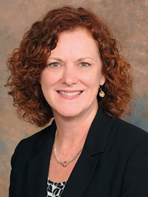
Prof Lisa L Hunter, PhD,
Scientific Director of Audiology,
Cincinnati Children's Hospital; Professor of Otolaryngology
and Communication Sciences and Disorders,
University of Cincinnati
Email: Lisa.hunter@cchmc.org
Audiology in this issue... Paediatric Audiology Gamechangers
Fifty years ago, the National Conference on Education of the Deaf followed up on the Babbidge Report of 1965, recognising the failure of oralism in deaf education. Because young, deaf children at that time did not have access to sound, they could not develop speech and language. Further, because children were identified at two years or later, early intervention was only a dream. The deaf education conference in 1967 recommended a high-risk register to facilitate identification, a public information campaign, and investigation of testing of infants five to 12 months of age. In 1969, the Joint Committee on Infant Hearing (JCIH) was established in the US and they urged study of newborn hearing screening. A critical development to that end was the discovery of otoacoustic emissions (OAEs) in 1978 by David Kemp and application to universal newborn screening in the 1990s. Parallel development of auditory brainstem responses based on work from 1974 by Hecox and Galambos enabled universal newborn hearing screening and diagnosis to be recommended by the JCIH in 2000. Programmes have since developed all over the world, making the dream of early intervention possible.
Fast forward to 2018, and how much has been accomplished during the past 50 years! But the story of early hearing loss detection and intervention (EHDI) is still developing. Prevention is key, and as explained by Karen Fowler, remarkable progress on that front is being made in screening and detection of congenital CMV, the most prevalent infectious cause of congenital hearing loss and neurologic disorders worldwide. Babies with congenital hearing loss, once identified, need early, appropriate and effective intervention. Ryan McCreery and Elizabeth Walker tell us about lessons learned from the Outcomes of Children with Hearing Loss (OCHL) study and how the puzzle pieces of intervention must be systematically put in place to achieve desired outcomes by age three years. Sheila Moodie describes the critical role of parent and caregiver engagement as central to this success.
We must also be able to measure speech perception to guide early habilitation efforts. Kristin Uhler describes behavioural and electrophysiologic methods for measuring speech perception in young children to determine if they are making progress with amplification. In a related article, Iain Jackson and colleagues propose whole facial recognition and machine learning approaches to hearing discrimination assessment. For children with single-sided deafness (SSD), traditional amplification cannot restore binaural hearing, thus cochlear implants are being researched to address this need. Karen Gordon, Sharon Cushing and Blake Papsin describe exciting research that demonstrates effective binaural integration of acoustic and electric hearing in children with SSD. As children grow and experience sound in their world, central auditory system and brain processing of sound is critical, but notoriously difficult to assess. David Moore and Harvey Dillon propose new subtraction techniques that may be a ‘gamechanger’ in assessment of auditory processing and listening difficulties.
It has truly been a joy to assemble this outstanding collection of paediatric audiology gamechangers, and I hope you’ll enjoy reading about their discoveries as much as I have. Each of these world-class researchers has in common the drive to put their discoveries into the hands of clinical audiologists to make evidence-based practice a reality.
Click here for the articles
Targeted CMV screening and hearing management of children with congenital cytomegalovirus infection
Karen Fowler
Lessons from the outcomes of children with hearing loss study
Ryan McCreery and Elizabeth Walker
Family-centred early intervention: supporting a call to action
Sheila Moodie
The importance of hearing aid validation in infants with hearing loss
Kristin Uhler
Facing up to the challenge of behavioural observation in infant hearing assessment
Iain Jackson, Lisa Hunter, David Moore, Pete Jones and Kevin Munro
Cochlear implantation in children with single-sided deafness: rationale and early findings
Karen Gordon, Blake Papsin and Sharon Cushing
How should we detect and identify deficit-specific auditory processing disorders?
David Moore and Harvey Dillon



